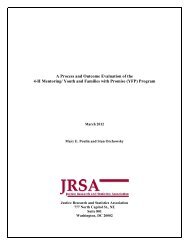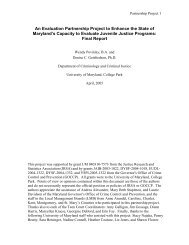A Review of the Status of DMC Efforts in Iowa and Virginia - April 2010
A Review of the Status of DMC Efforts in Iowa and Virginia - April 2010
A Review of the Status of DMC Efforts in Iowa and Virginia - April 2010
You also want an ePaper? Increase the reach of your titles
YUMPU automatically turns print PDFs into web optimized ePapers that Google loves.
was possible. However, we <strong>of</strong>fer <strong>the</strong> ideal assessments as models that jurisdictions should strive<br />
toward when attempt<strong>in</strong>g to determ<strong>in</strong>e <strong>the</strong> success <strong>of</strong> <strong>DMC</strong> efforts that are similar to those<br />
assessed here. When <strong>the</strong> designs discussed <strong>in</strong> <strong>the</strong> ideal assessments are not possible jurisdictions<br />
should, at a m<strong>in</strong>imum, carry out <strong>the</strong> steps listed below to assess <strong>the</strong>ir efforts.<br />
• Use RRI data over several time periods (annually or more frequent time periods such as<br />
quarterly) to document that a problem exists.<br />
• Use a recent assessment study (with<strong>in</strong> <strong>the</strong> past few years) to expla<strong>in</strong> why <strong>the</strong> problem<br />
exists. If a recent assessment study is not available, <strong>of</strong>fer reason(s) why it is thought that<br />
<strong>the</strong> problem exists.<br />
• Clearly describe <strong>the</strong> effort prior to its implementation. Include <strong>the</strong> target population, all<br />
<strong>the</strong> components/activities <strong>of</strong> <strong>the</strong> effort <strong>and</strong> <strong>the</strong> <strong>in</strong>dicators <strong>of</strong> whe<strong>the</strong>r <strong>the</strong>se activities are<br />
implemented as planned, how long <strong>the</strong> effort should take (if applicable), <strong>and</strong> what <strong>the</strong><br />
<strong>in</strong>dicators <strong>of</strong> success are.<br />
• Ensure data are available to document <strong>the</strong> implementation <strong>and</strong> outcomes <strong>of</strong> <strong>the</strong> effort<br />
prior to its implementation.<br />
• Use <strong>the</strong> data collected to assess <strong>the</strong> success <strong>of</strong> <strong>the</strong> effort.<br />
• Document all <strong>of</strong> <strong>the</strong>se steps <strong>and</strong> make <strong>the</strong> results publicly available.<br />
Summary<br />
Our assessment <strong>of</strong> <strong>the</strong> accumulated evidence on <strong>DMC</strong> <strong>in</strong>terventions is that <strong>the</strong>re is some<br />
evidence to suggest some promis<strong>in</strong>g <strong>DMC</strong> <strong>in</strong>terventions, almost exclusively at <strong>the</strong> detention<br />
stage. Systemic <strong>in</strong>terventions, such as JDAI <strong>and</strong> <strong>the</strong> Burns Institute approaches, seem to have <strong>the</strong><br />
benefit <strong>of</strong> energiz<strong>in</strong>g, at least temporarily, local efforts to address <strong>the</strong> <strong>DMC</strong> issue, <strong>and</strong> both<br />
efforts <strong>of</strong>fer some numbers that suggest reductions <strong>in</strong> <strong>DMC</strong>. There is no evidence that meets any<br />
30
















